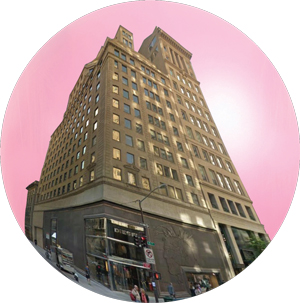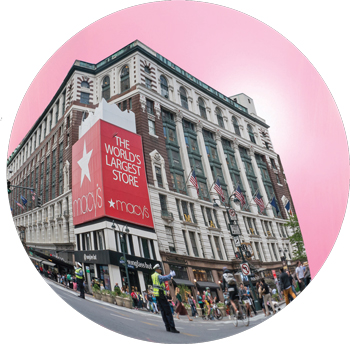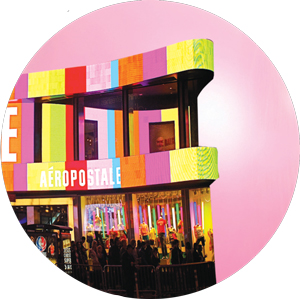Trending
Is NYC’s retail bubble about to pop?
With average rents peaking and a growing number of stores in hot water, concerns over Manhattan’s retail market are becoming palpable

When 685 Fifth Avenue hit the market two years ago, investors practically lined up around the block. The building’s roughly 25,000-square-foot retail space — which sits on the corner of 54th Street — came with 152 feet of frontage in the heart of Manhattan’s most profitable shopping district. Best of all, the property’s only retail tenant, Gucci, was about to leave, allowing any buyer to sign a new tenant in a neighborhood where asking rents were growing at an annual average of 8 percent.
Who wouldn’t want to get in on that? Joseph Sitt’s Thor Equities and the shopping mall giant General Growth Properties, helmed by Sandeep Mathrani, certainly did.
In July 2014, the two firms joined forces and paid $475 million for the 20-story building, which also includes 90,000 square feet of office space. Soon after, the partners began actively marketing the property’s retail.
According to sources familiar with the project, however, reality has not quite lived up to expectations.
In February, the owners landed the luxury fashion designer Coach as a tenant for a 10-year lease with a rent of about $4,000 per square foot. While that may seem like a major coup, sources say Thor and GGP had to offer deeper concessions than expected: The landlords agreed to pay for the space’s build-out, which can cost up to $1,000 per square foot for a prime retail location.

685 Fifth Avenue
And in the end, Coach didn’t take the entire ground-floor space, leaving the building’s owners with about 900 remaining square feet.
“On the face value it looks like they got a very high rent, but if you count in concessions it looks different,” said Faith Hope Consolo, chair of the retail division at Douglas Elliman.
A representative for Thor declined to comment.
Thor and GGP will still collect about $20 million in annual rent for the retail space, according to one source, and the partners entered contract to sell the building’s office portion to the Turkish real estate and jewelry company the Gülaylar Group for $160 million in March, meaning their initial investment will likely net them a hefty overall profit. But the concessions offered to Coach point to a broader concern in Manhattan’s retail market: Luxury and non-luxury tenants are becoming less willing to pay the kinds of rents owners demand.
These days, hardly a week goes by without a new report about struggling retailers and rising vacancies in Manhattan. Average retail asking rents fell year over year in seven of the borough’s 12 main retail submarkets in the first quarter of 2016, according to Cushman & Wakefield. And several prime shopping districts now have availability rates well over 20 percent, while stretches on Bleecker Street and Broadway have become notorious for their empty storefronts.
These signs of trouble are coinciding with record spending by retail investors and the rise of the retail condo.
Investors have shelled out $25 billion on Manhattan retail properties since the beginning of 2011, according to data from Real Capital Analytics. And in recent years, buyers have been more willing to dig deeper into their wallets and accept higher per-square-foot prices — forcing them to find tenants willing to pay high rents to justify their purchases.
Since 2000, RCA’s database counts 24 Manhattan retail condo sales that were priced at $10,000 per square foot or more. All of them closed after July 2011 and 17 closed in 2014 and 2015.
“I don’t want to say it’s a bubble but it’s been constantly bid up for six years,” Lee & Associates Managing Principal Peter Braus told The Real Deal.
Consolo added that retail condo sales prices have gone into the “stratosphere” in recent years.
“It is clear that there were numbers that were far too aggressive and the market just couldn’t keep up,” she said.
What goes up …
While real estate insiders are reluctant to call it a retail bubble, many acknowledge that a correction is imminent.
Michael Weiser, president of commercial brokerage GFI Realty Services, said the best indicator of whether Manhattan’s retail market is weakening is vacancy.

Sandeep Mathrami
Availability rates — which measure the amount of retail space that is vacant or will become available — rose in all but one of Manhattan’s main retail submarkets between the first quarters of 2015 and 2016, according to Cushman.
Among those neighborhoods, several stand out: On Fifth Avenue between 42nd and 49th streets, a staggering 31 percent of retail space was available for lease. Meanwhile, Soho clocked in with a 25 percent availability rate followed by Herald Square and the Meatpacking District (both at 22 percent), Times Square (20 percent) and Madison Avenue (17 percent).
Braus said that owners who paid a steep price for retail space are more reluctant to accept lower rents. “That’s one reason why you’re seeing a lot of vacancies in those neighborhoods,” he noted.
As it happens, those six districts were also home to the bulk of the priciest Manhattan retail purchases in the last two and half years, accounting for 57 of the 73 sales priced at $100 million or more recorded by RCA since January 2014. (That excludes office properties with retail components.) They are also among the neighborhoods where asking rents saw the steepest rise over the past two years, the numbers from Cushman & Wakefield show.
Between mid-2010 and mid-2015, asking rents almost quadrupled around Times Square, tripled on Fifth Avenue between 42nd and 49th streets and jumped by about 90 percent in Soho and on Madison Avenue.
By comparison, retail asking rents in other areas such as the Upper West Side and on Third Avenue grew by about 35 percent in the same time span.
In other words, the submarkets struggling the most with high availability rates today are those where investors spent the most on retail properties compared to previous years and where landlords jacked up their asking rents at a faster pace.
Some brokers argue that those two factors get to the heart of Manhattan’s retail conundrum: Investors have been overpaying for store space. In order to make a profit, they now need to charge rents that few tenants — even high-end brands — can afford.
Without the ideal location and ideal tenant, many of those investors “will not get the kind of money they need to make returns,” said office and retail broker Norman Bobrow, who heads his own Madison Avenue-based firm. “I believe people are making mistakes,” he told TRD. “They are daydreaming.”
Some observers don’t just fear that many retail investors overpaid, but argue that they are betting on a dying asset class.
“If there’s one area that I’m concerned about, it’s retail,” real estate investor and former New York Governor Eliot Spitzer said in June at a conference hosted by the Israeli Building Center, adding that he does his shopping on Amazon nowadays.
Bobrow said he believes Manhattan’s retail market is at the beginning of a long decline and that the worst has yet to come.

151 West 34th Street
Department stores are disappearing and restaurants are grappling with rising labor costs, leaving owners of large retail spaces in the city with fewer viable tenants, he argued.
“As for the regular New Yorkers, I find less and less of them going into stores,” Bobrow said.
To be sure, plenty of luxury and non-luxury retail tenants continue to ink leases throughout the city. Meanwhile, the outer boroughs have been experiencing a retail renaissance with a growing number of artisanal shops and restaurants in neighborhoods such as Downtown Brooklyn and Long Island City.
Still, the retail skeptics have plenty of evidence to point to. Major retailers including the Gap and Macy’s — both of which occupy large Manhattan spaces — saw their sales drop by 5 and 5.6 percent, respectively, year over year in the first quarter. Meanwhile, Ralph Lauren in June announced it would cut 8 percent of its workforce. All three firms announced store closures this year.
Macy’s, whose flagship store by Herald Square is arguably Manhattan’s most famous retail space, announced mass layoffs in January. And in May, Amazon overtook the department store chain as the largest clothing seller in the U.S.
The struggles retailers are facing combined with rising rents in the city have already begun to impact Manhattan’s retail landlords.
In May, Aéropostale filed for bankruptcy and announced it would close its 19,000-square-foot store at SL Green’s 1515 Broadway, where it had signed a lease in 2010. And last year, Toys R’ Us ditched more than 100,000 square feet of flagship retail space at Charles Moss’ 1514 Broadway, where the company had been an anchor for 16 years.
Managing expectations
If store closures continue, the supply of available retail space could spike and drag down prime rents, some industry players noted. That would be an unwelcome turn of events for retail owners.
Since the beginning of the recovery following the last financial crisis, New York’s biggest retail investors have been pouring billions of dollars into the sector, fueling what some call “frothiness” if not an outright price bubble.
Jeff Sutton, for one, has purchased $2.96 billion worth of prime Manhattan retail properties in 18 deals over the past five years, according to RCA, which found that he was the most active investor in the sector during that time period.
Indeed, Sutton’s Wharton Properties was a key player in the priciest retail acquisition in New York history: the $1.3 billion purchase of the Crown Building’s retail space in May 2015 in partnership with GGP. And in September 2015, Sutton and Bobby Cayre’s real estate investment firm Aurora Capital Associates signed a 99-year triple-net lease for 511 Fifth Avenue in Midtown in a deal valued at $174 million in public records. But since then, the king of Manhattan retail has been a bit quieter on the retail front.
Following Sutton on RCA’s tally are GGP, Vornado Realty Trust and Thor, which bought 44 Manhattan retail properties (more than any firm) over the past five years.
 But many of the biggest players are slowing down on their acquisitions, while others are beginning to sell off assets in large quantities. That includes Thor, which is looking to unload multiple properties on Fifth Avenue and elsewhere.
But many of the biggest players are slowing down on their acquisitions, while others are beginning to sell off assets in large quantities. That includes Thor, which is looking to unload multiple properties on Fifth Avenue and elsewhere.
GFI’s Weiser said companies such as Wharton, Thor, Vornado and GGP would have little trouble withstanding a retail market correction thanks to their size. Similarly, other long-term owners are also cushioned due to their low cost basis, he noted.
But while the big players are likely to be fine, the ones in the middle will be squeezed, Weiser said.
Lenders who’ve bet big on Manhattan retail could suffer too. In a recent report, the rating agency Morningstar Credit Ratings analyzed 231 commercial mortgage-backed securities (CMBS) loans tied to retail properties occupied by the financially strapped Gap. Morningstar found 14 loans on properties where Gap occupies more than 80 percent of the space on a lease that expires within the next two years, which could put landlords and the investors in those loans at risk if the company decides to close more stores. Two of those properties — the Shops at Bruckner Boulevard in the Bronx and 31-48 Steinway Street in Astoria — are located in New York City, just outside of Manhattan.
At press time, six CMBS loans tied to New York City retail properties were in special servicing, according to the CMBS research firm Trepp. The aggregate book value of those loans is less than $70 million. But that number could rise, due to falling rents and rising vacancies, according to sources.
“If you acquired your retail property in the past two years, you are in this situation where if you don’t hit certain minimum rents, it can be to the detriment of your business plan and the underlying mortgage,” said one mortgage broker who asked to remain anonymous.
Additionally, a retail decline could have a big impact on new residential development throughout the city.
The perceived value of ground-floor retail has been a big factor in helping to fan New York’s most recent residential construction boom, allowing developers to justify high prices on land and to underwrite big construction loans. That’s because returns on retail tend to be significantly higher than returns on apartments, especially on lower floors, where the retail is housed.
As a result, developers have tried to squeeze as much retail as possible into their projects. Harry Macklowe is including three stories of retail in his condo conversion at One Wall Street and nearly 30,000 square feet of retail at his ground-up condo skyscraper at 432 Park Avenue.
One residential broker, speaking on the condition of anonymity, said the reliance on pricey retail space could put condo developers at risk, as a surge of new supply begins to drive down retail values.
Yet, Manhattan’s high-profile condo and office development projects are relying on big luxury retail chains more than ever.
Extell Development’s Central Park Tower at 217 West 57th Street — which has yet to secure a construction loan — has locked in a 363,000-square-foot Nordstrom department store as its anchor tenant.

515 Broadway
And a 250,000 square-foot Neiman Marcus store will anchor Related Companies’ and Oxford Properties Group’s 1-million-square-foot retail complex at Hudson Yards on Manhattan’s Far West Side.
But both retailers are having a tough year amid rising online competition.
Neiman Marcus saw its earnings plummet 81 percent year over year in the first quarter, while Nordstrom’s profits fell by 64 percent. There is no indication that these lackluster numbers will have any impact on the retailers’ commitment to those two projects, but the drop doesn’t exactly instill confidence either.
As for the other high-priced retail space hitting the market, “you can’t have that many flagship stores,” said Braus of Lee & Associates. “What’s going to fill up all of these stores?”
He argued that Manhattan’s retail market is turning into a two-speed highway. Companies like Apple, whose stores offer enough gadgets and design to double as entertainment venues, will remain in the fast lane, Braus said. As a result, landlords who can offer those tenants locations with heavy foot traffic and the right layout can still demand high rents. But there are only so many of those retailers to go around. And there are a lot of tenants (including bookstores and some clothing retailers) in the slow lane.
“A lot of that is just the changing landscape,” said commercial broker Adelaide Polsinelli of Eastern Consolidated. “It’s survival of the fittest.”
Bulls to the rescue?
As Thor and GGP were putting the finishing touches on their lease with Coach at 865 Fifth Avenue, Thor began quietly marketing a big chunk of its Manhattan commercial portfolio. That has led some observers to speculate that the company is effectively calling a retail market peak.
But early signs may indicate otherwise.
In May, Thor sold its office and retail building at 693 Fifth Avenue to French Billionaire Marc Ladreit de Lacherriere for $525 million — almost four times the $142 million Thor paid for the building in 2010. Longtime retail broker John Brod of ABS Real Estate Partners said he believes Thor won’t have much difficulty selling the other properties either.
“To Thor’s credit, when they do sell they’re actually doing a lot better than if they would have rented them out,” he said.
Five Manhattan retail properties sold for more than $100 million between January and May, the same amount as a year earlier. The first few months of 2016 also saw the third and fourth most expensive retail condo sales in the city’s history — 139 Spring Street to Invesco for $25,843 per square foot and 106 Spring Street to the Carlyle Group for $17,559 per square foot, according to RCA.
All of that activity raises a fundamental question: Why is an industry widely considered to be struggling such a booming asset class in real estate?

Robert Futterman
The most obvious answer is that many investors and observers don’t believe that retail is in trouble, at least not in Manhattan. After all, people have been predicting the end of brick-and-mortar stores for two decades while demand for Manhattan retail space continued to grow.
“I think the Internet is more of a factor outside of the urban areas; that’s where the big mall developers are going to have to be creative,” said Robert Futterman, head of the retail brokerage RKF.
Retail bulls argue that even if brick-and-mortar sales continue to decline across the country, Manhattan will stay strong because so many companies use their retail space as showcases to establish and promote their brands.
“It’s less about making money and more about advertising,” said GFI’s Weiser. “As a general rule, flagship stores don’t have to be profitable.”
In addition, compared to worries over a slowdown in the condo and office markets, the retail softening might not be that bad.
Ronald Dickerman, whose firm Madison International Realty owns stakes in 2.5 million square feet of retail space across New York City, argued that retail today offers better returns than office space.
The more nuanced explanation for retail’s popularity among investors has less to do with Manhattan market fundamentals and more to do with the global flow of capital.
In an age of loose monetary policy, there is an abundant amount of capital-chasing investment opportunities. As a comparatively stable asset, real estate holds particular appeal and buying retail properties is one of the easiest ways to invest a lot of money in real estate.
While apartment, office and hotel properties are complex and require plenty of maintenance, smaller retail properties and condos generally take care of themselves once they are leased out. This makes retail attractive to wealthy families and funds that want to invest in real estate but don’t want to spend time and resources hiring facilities teams or battling residential tenants in court.
“Retail is seen as less intense and less involved in terms of management,” said Weiser, adding that this makes retail properties an attractive proposition for anyone who has to spend a lot of money quickly.
In that sense, prime Manhattan retail condos share some similarities with the housing market in the mid-2000s. Much like securitized residential mortgages prior to 2008, many see New York retail as a safe, low-maintenance asset that will almost inevitably rise in value in the long term, as it has in the past.
Does this mean retail prices could become similarly inflated as housing prices pre-2008 and ultimately crash?
Dickerman doesn’t think so. “I would rather make a retail investment today than an office or residential investment,” he told TRD. “It’s clear that my grandchildren will walk down 52nd Street and have a retail experience.”
Still, he acknowledged that some recent retail investors may have been paying a steep price. “If you’re talking about a 2 percent cap rate for the St. Regis retail space, you’re going to have to justify some pretty substantial rent growth,”
he said.
Others have deeper concerns about the impact of a major correction. Braus said that if the retail malaise continues, defaults and other problems could soon follow. “There will be people left standing without a chair when the music stops,” he said.




